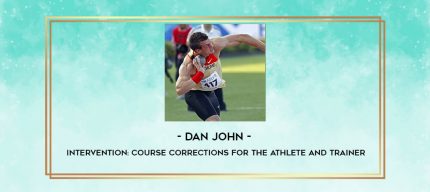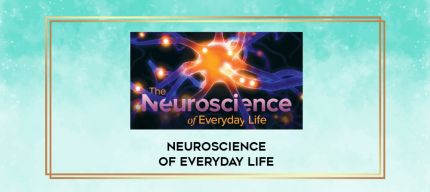Neuroscience of Everyday Life
Course Description
Archive : Neuroscience of Everyday Life Digital Download
Salepage : Neuroscience of Everyday Life
Delivery : Online With Any Device
Your nervous system is you. All the thoughts, perceptions, moods, passions, and dreams that make you an active, sentient being are the work of this amazing network of cells. For many centuries, people knew that this was true. But no one was sure how it happened.
Hide Full Description
Now, thanks to the exciting new field of neuroscience, we can chart the workings of the brain and the rest of the nervous system in remarkable detail to explain how neurons, synapses, neurotransmitters, and other biological processes produce all the experiences of everyday life, in every stage of life. From the spectacular growth of the brain in infancy to the act of learning a skill, falling in love, getting a joke, revising an opinion, or even forgetting a name, something very intriguing is going on behind the scenes.
For example, groundbreaking research in the past few decades is now able to explain such phenomena as these:
Decisions: Studies of decision making at the level of neurons show that our brain has often committed to a course of action before we are aware of having made a decision-an apparent violation of our sense of free will.
Memory: Memory is composed of many systems located in different parts of the brain, which means that you can forget your car keys (information stored in the neocortex) but still remember how to drive (a learned skill requiring the striatum and cerebellum).
Willpower: Willpower is more than a metaphor; it’s a measurable trait that draws on a finite mental resource, like a muscle. While any given individual has a consistent willpower capacity throughout life, it can be strengthened through training-again, just like a muscle.
Religion and spirituality: Three mental traits appear to be essential for the development of organized religion: the search for causes and effects, the ability to reason about people and motives, and language. Mystical experiences also trace to specific activities of the brain.
Opening your eyes to how neural processes produce the familiar features of human existence, The Neuroscience of Everyday Life covers a remarkable range of subjects in 36 richly detailed lectures. You will explore the brain under stress and in love, learning, sleeping, thinking, hallucinating, and just looking around-which is less about recording reality than creating illusions that allow us to function in our environment.
Your professor is distinguished neuroscientist and Professor Sam Wang of Princeton University, an award-winning researcher and best-selling author, public speaker, and TV and radio commentator. Professor Wang’s insightful and playful approach makes this course a joy for anyone who wants to know how his or her own brain works. And his vivid, richly illustrated presentation assumes no background in science.
Fact or Fiction?
Professor Wang points out that a lot of what we think we know about our brains turns out to be wrong. While bringing you up to date on the latest discoveries in the field, he debunks the following persistent myths:
We use only 10% of our brains: Your brain is actually running at 100%! The myth about idle brain power has been promoted by self-help gurus and doesn’t stand up to evidence from cases of brain damage, which always cause deficits in function.
Mozart makes babies smarter: Playing classical music may help calm you down around an infant, but it’s not doing anything for the baby. The better strategy is to have children learn to play a musical instrument when they’re older, which does improve brain development.
Women are moodier than men: Studies show that the sexes are tied in the moodiness contest, with men reporting just as frequent mood swings as women. However, both men and women tend to remember women’s mood swings better.
We lose brain cells as we age: The brain is supposedly unique as an organ because it stops adding new cells after birth. In fact, some parts of the brain keep producing new neurons throughout life. The brain shrinks somewhat with age, but its neurons live on.
Tune Up Your Brain!
Operating on about the power consumed by an idling laptop, the brain has often been compared to a computer. But this, too, is a myth. Computers are logically straightforward in design, whereas the brain is a marvel of evolutionary makeshift, with layer upon layer of systems that started out with one function and then were adopted for something completely different. Some of the most primitive functions of the brain, such as the fight-or-flight response to danger, resist being overridden by the brain’s powerful reasoning center, which evolved more recently.
Indeed, much of what the brain does is beyond our conscious control. Yet in some cases, there are ways to intervene. Here are some tips that Professor Wang offers to make your brain run at its optimum:
How to stick to a health regimen: If you use your nondominant hand to brush your teeth for two weeks, this can lead to a measurable increase in your willpower capacity. People who do this are then able to follow a diet or exercise program better.
Efficient learning: Don’t cram! Spread out your study over several sessions. This allows your brain time to process what you’ve learned, which requires no additional effort on your part and greatly increases your retention of information.
Resetting your biological clock: The best way to beat jet lag is to use light, which cues your brain to where it is in the day/night cycle. For a flight between the United States and Europe, in either direction, a dose of afternoon sunlight after you arrive should help you adjust.
The best brain exercise is real exercise: Cognitive functions that normally deteriorate with age, such as memory and response time, can be boosted by aerobic exercise. The effect is largest if you are active starting in middle age, but it’s never too late to start.
The Research Subject Is You
Turning from processes that are merely hidden to those that are utterly mysterious, The Neuroscience of Everyday Life also sheds light on these phenomena:
Love: Prairie voles are a fascinating model for studying human mating, since, unlike most other mammals, they are monogamous. For them as well as for us, the neurotransmitters oxytocin and vasopressin control the expression of pair bonding, better known as love.
Humor: Smiles and laughter are two emotional components of humor that have deep roots as social signals. Another component is characterized by the sudden flash of insight that occurs when we -geta joke; brain scanners show where this happens.
Haunted houses: Neurological phenomena that people have associated with haunted houses, such as the feeling of an invisible presence, also occur from carbon monoxide poisoning-a once-common problem in houses lit with gas. Reports of haunted houses have dropped sharply with the decline in gas lighting.
Consciousness: Our conscious awareness extends to only a fraction of the stimuli registered by our brains, like a spotlight focusing on a tiny portion of a flood of data. Experiments show that we often act on unconscious information without being aware of it.
Professor Wang notes that it was his fascination with consciousness, free will, and other big ideas that led him to switch from physics, which he studied as an undergraduate, to a field he regards as even more alive with possibilities for breakthroughs that will change our worldview in fundamental ways.
That field, of course, is neuroscience. The Neuroscience of Everyday Life is your chance to explore a discipline that is now going through its golden age, with the advantage that the subject is not some abstract entity.
It’s you.
Health and Medical course
More information about Medical:
Medicine is the science and practice of establishing the diagnosis, prognosis, treatment, and prevention of disease.
Medicine encompasses a variety of health care practices evolved to maintain and restore health by the prevention and treatment of illness.
Contemporary medicine applies biomedical sciences, biomedical research, genetics, and medical technology to diagnose, treat, and prevent injury and disease,
typically through pharmaceuticals or surgery, but also through therapies as diverse as psychotherapy, external splints and traction, medical devices, biologics, and ionizing radiation, amongst others.
Medicine has been around for thousands of years, during most of which it was an art (an area of skill and knowledge) frequently having connections to the religious and
philosophical beliefs of local culture. For example, a medicine man would apply herbs and say prayers for healing, or an ancient philosopher and physician would apply bloodletting according to the theories of humorism.
In recent centuries, since the advent of modern science, most medicine has become a combination of art and science (both basic and applied, under the umbrella of medical science).
While stitching technique for sutures is an art learned through practice, the knowledge of what happens at the cellular and molecular level in the tissues being stitched arises through science.
More from Categories : Health & Fitness























Reviews
There are no reviews yet.